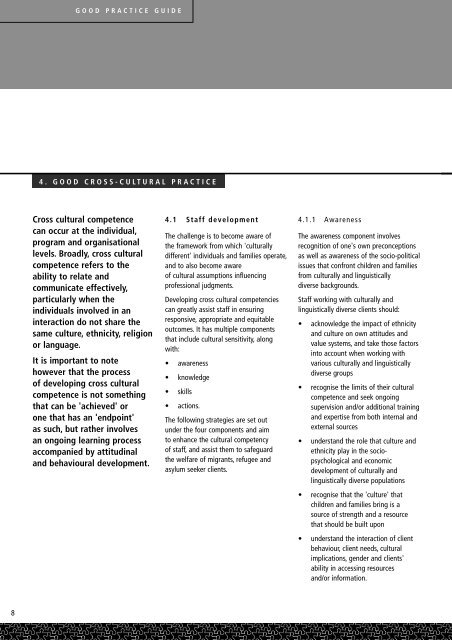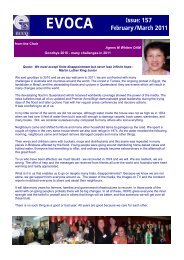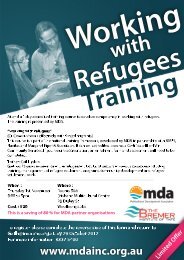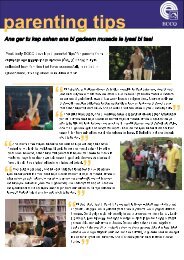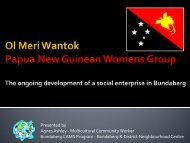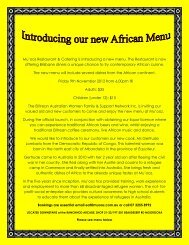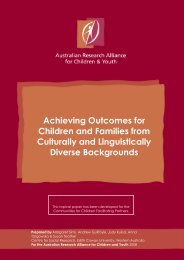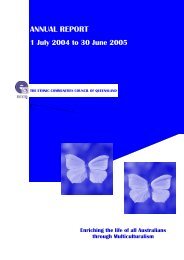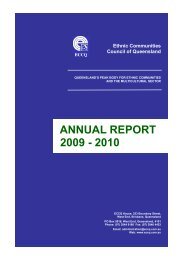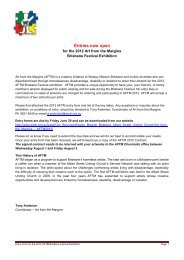Good Practice Guide
CALD Good practice guide
CALD Good practice guide
Create successful ePaper yourself
Turn your PDF publications into a flip-book with our unique Google optimized e-Paper software.
GOOD PRACTICE GUIDE<br />
4. GOOD CROSS-CULTURAL PRACTICE<br />
Cross cultural competence<br />
can occur at the individual,<br />
program and organisational<br />
levels. Broadly, cross cultural<br />
competence refers to the<br />
ability to relate and<br />
communicate effectively,<br />
particularly when the<br />
individuals involved in an<br />
interaction do not share the<br />
same culture, ethnicity, religion<br />
or language.<br />
It is important to note<br />
however that the process<br />
of developing cross cultural<br />
competence is not something<br />
that can be 'achieved' or<br />
one that has an 'endpoint'<br />
as such, but rather involves<br />
an ongoing learning process<br />
accompanied by attitudinal<br />
and behavioural development.<br />
4.1 Staff development<br />
The challenge is to become aware of<br />
the framework from which 'culturally<br />
different' individuals and families operate,<br />
and to also become aware<br />
of cultural assumptions influencing<br />
professional judgments.<br />
Developing cross cultural competencies<br />
can greatly assist staff in ensuring<br />
responsive, appropriate and equitable<br />
outcomes. It has multiple components<br />
that include cultural sensitivity, along<br />
with:<br />
• awareness<br />
• knowledge<br />
• skills<br />
• actions.<br />
The following strategies are set out<br />
under the four components and aim<br />
to enhance the cultural competency<br />
of staff, and assist them to safeguard<br />
the welfare of migrants, refugee and<br />
asylum seeker clients.<br />
4.1.1 Awareness<br />
The awareness component involves<br />
recognition of one's own preconceptions<br />
as well as awareness of the socio-political<br />
issues that confront children and families<br />
from culturally and linguistically<br />
diverse backgrounds.<br />
Staff working with culturally and<br />
linguistically diverse clients should:<br />
• acknowledge the impact of ethnicity<br />
and culture on own attitudes and<br />
value systems, and take those factors<br />
into account when working with<br />
various culturally and linguistically<br />
diverse groups<br />
• recognise the limits of their cultural<br />
competence and seek ongoing<br />
supervision and/or additional training<br />
and expertise from both internal and<br />
external sources<br />
• understand the role that culture and<br />
ethnicity play in the sociopsychological<br />
and economic<br />
development of culturally and<br />
linguistically diverse populations<br />
• recognise that the 'culture' that<br />
children and families bring is a<br />
source of strength and a resource<br />
that should be built upon<br />
• understand the interaction of client<br />
behaviour, client needs, cultural<br />
implications, gender and clients'<br />
ability in accessing resources<br />
and/or information.<br />
8


